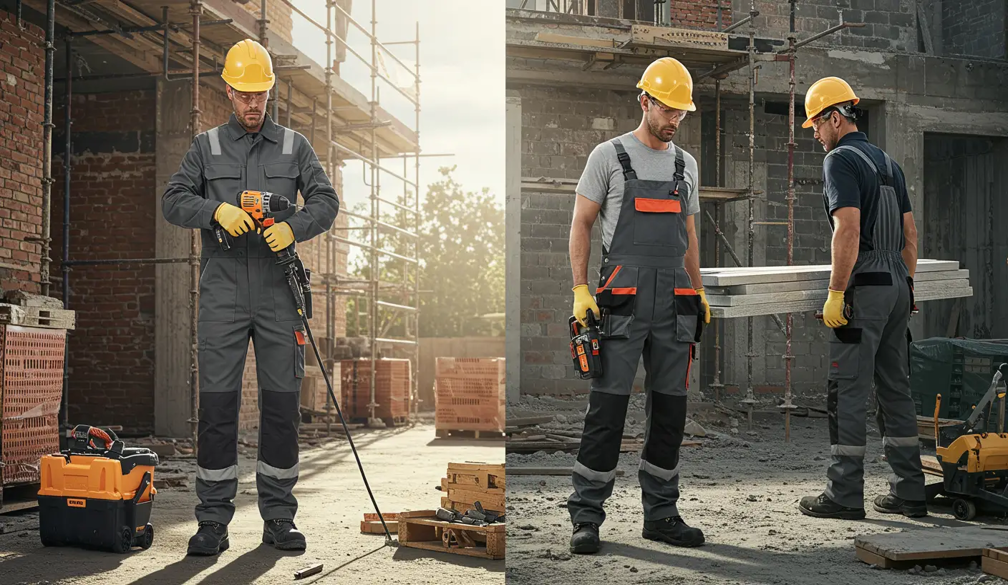Coveralls vs Overalls: Choose The Perfect Safety Gear

Selecting the right protective clothing is crucial for ensuring worker well-being and compliance with safety regulations. Coveralls and overalls are the two commonly utilized garments in different industries. Understanding their distinct features, advantages, and appropriate usage scenarios is essential for making informed decisions regarding workplace safety attire.
What is Coverall?
Coveralls are one-piece garments made to provide full-body protection. To offer coverage from the neck down to the ankles, they typically feature long sleeves and full-length pant legs. This design makes sure that the arms and legs are protected from various workplace hazards.
Key Features of Coveralls
- Full-Body Coverage: Coveralls minimize exposure to harmful substances and environmental elements as they cover the entire body.
- One-Piece Design: To reduce the risk of contaminants penetrating the clothing, the integrated structure eliminates gaps between upper and lower body garments.
- Variety of Materials: Coveralls are made from materials such as cotton, polyester blends, Nomex, and polypropylene, depending on the use.
When to Use Coveralls
Coveralls are particularly suited for environments where comprehensive protection is required. Scenarios include:
- Chemical Handling: Workers wear coveralls made of chemically resistant materials to prevent skin contact if they are dealing with hazardous chemicals.
- Fire-Prone Areas: Flame resistant coveralls are needed in industries like oil and gas, welding, and firefighting to protect against burns.
- Medical and Laboratory Settings: Disposable coveralls are essential for protecting against biological contaminants and maintaining hygiene standards.
- Construction and Manufacturing: Durable coveralls are used to protect against physical hazards such as sharp objects, machinery, and debris.
What is overall?
Overalls are two-piece garments consisting of trousers with an attached bib that covers the chest and is held up by adjustable shoulder straps. Overalls are two-piece garments made of trousers with an attached bib that covers the chest and is fastened with adjustable shoulder straps. To allow for greater mobility, overalls leave the arms and shoulders exposed.
Key Features of Overalls
- Partial Body Coverage: Overalls offer protection for the lower torso and legs while leaving the arms free. They also provide additional coverage over the chest.
- Adjustable Fit: Overalls are designed to fit a wide range of body sizes and shapes.
- Multiple Pockets: Overalls often come with several pockets, providing convenient storage for tools and personal items.
- Durable Materials: Constructed from sturdy fabrics like denim or heavy-duty cotton, overalls are designed to withstand rigorous use.
When to Use Overalls
- Overalls are suitable for situations where lower body protection is sufficient and upper body mobility is a priority.
- Agriculture and Farming: Overalls provide protection against dirt and minor abrasions while allowing freedom of movement necessary for tasks like planting and harvesting.
- Carpentry and Woodworking: To make them suitable for craftsmen, the design facilitates ease of movement and provides pockets for carrying tools.
- Casual Industrial Work: Overalls provide adequate protection without offering full body coverage in environments with minimal exposure to hazardous substances.
- Outdoor Maintenance: Overalls protect against soil and debris while permitting comfortable movement for tasks such as landscaping or gardening.
Comparing Coveralls and Overalls
It is important to understand the difference between coveralls and overalls for selecting the right protective gear. Key differences include:
- Coverage: Coveralls offer full-body protection, whereas overalls cover only the lower body and chest, leaving arms exposed.
- Protection Level: Coveralls offer greater protection against hazardous substances and environments due to their extensive coverage.
- Mobility and Comfort: Overalls are flexible and are more comfortable in warmer conditions due to increased ventilation.
- Use Cases: Coveralls are needed in high-risk environments requiring full-body protection, while overalls are ideal for tasks needing lower body protection and upper body flexibility.
Importance of Selecting the Right Protective Gear
Identifying workplace hazards, comfort requirements, and compliance with safety standards should be considered while choosing between coveralls and overalls. Factors to consider include:
- Nature of Work: To determine the necessary level of protection, identify potential risks such as chemical exposure, fire hazards, or physical injuries.
- Environmental Conditions: To ensure the selected garment provides comfort and functionality, consider temperature, weather, and workplace setting.
- Regulatory Compliance: Make sure that the chosen protective clothing meets industry-specific safety standards and regulations.
- Material Selection: While considering factors like durability, breathability, and ease of maintenance, choose materials that offer the required protection.
Consider authoritative sources such as the Occupational Safety and Health Administration (OSHA) and National Institute for Occupational Safety and Health (NIOSH) for guidance on safety standards and regulations.
Both coveralls and overalls play significant roles in ensuring worker safety across various industries. It is essential to understand their differences, advantages, and appropriate usage scenarios for selecting the right protective gear. Employers and workers can make informed decisions that enhance safety, comfort, and productivity by carefully evaluating workplace hazards, environmental conditions, and compliance requirements.









